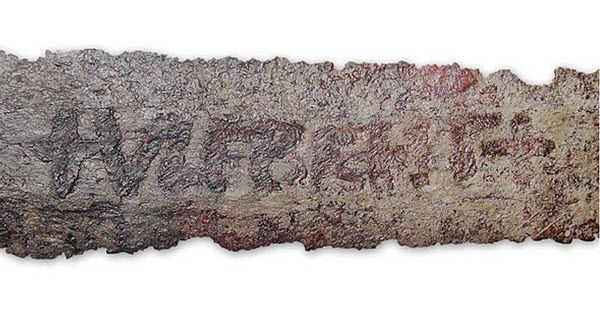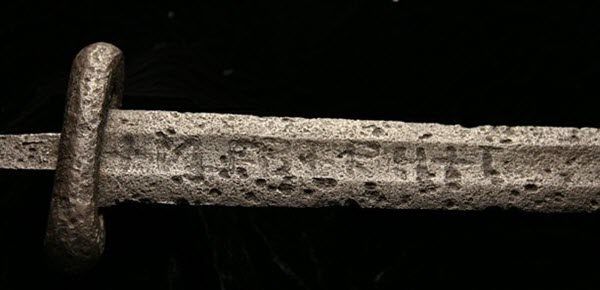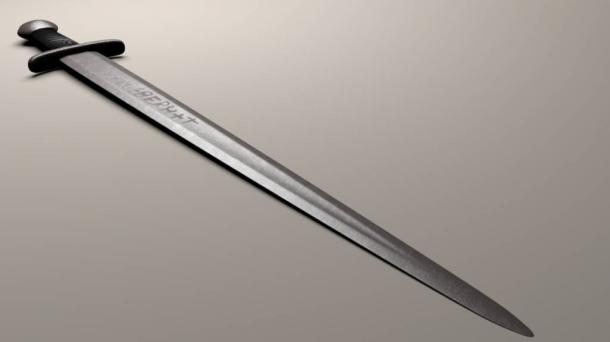A Step Closer to the Mysterious Origin of the Viking
Sword Ulfberht
Ulfberht was like a Medieval luxury brand for swords—but unlike your Gucci purse, the swords were of such high quality they were almost … mystical.
Dozens of these swords—made with metal so strong and pure it’s baffling how any sword maker of that time could have accomplished it—have been found in Europe, along with some knock-offs. They are all marked with the Ulfberht name and two crosses, though some of the imitations are missing a letter here or there.
New research brings us closer to the source of the swords, to the kiln in which these legendary weapons were forged.
A previous theory held that the swords may have their origin in the Middle East or Asia, but surprisingly it seems the materials were sourced closer to where they were found, in Central Europe.
At the time the Ulfberht swords were forged (approximately 800–1000 A.D.), equally perplexing swords made of a substance called Damascus steel were being produced in the Middle East out of a raw material, known as Wootz steel, from Asia. Both Damascus steel and the Ulfbehrt’s so-called “crucible steel” had high amounts of carbon.
Ulfberht’s Perplexing Composition
Carbon can make or break a sword; if it’s not controlled to just the right amount, the sword will be either too soft or too brittle. But with just the right amount, carbon greatly strengthens the blade. The Ulfberht has a carbon content about three times higher than that of other swords of its time. It would have been astoundingly stronger and yet more flexible than other swords, as well as light-weight. It also had almost no impurities, known as slag. This would have allowed for a more even distribution of carbon.
It was thought, before Ulfberht was discovered, that the capability to remove slag to such a degree only became possible during the Industrial Revolution. Iron ore must be heated to 3,000 degrees Fahrenheit to accomplish this, a feat the Ulfberht makers apparently accomplished 800 years ahead of their time. With great effort and precision, modern blacksmith Richard Furrer of Wisconsin forged a sword of Ulfberht quality using technology that would have been available in the Middle Ages. He said it was the most complicated thing he’d ever made, and he used methods not known to have been used by people of that time.
Damascus Steel’s Perplexing Composition
The secret of making the Middle East’s Damascus Steel has only reemerged under the inspection of scanning electron microscopes in modern laboratories. It was first used around 300 B.C. and the knowledge seems to have been inexplicably lost around the mid-18th century.
Digital reconstruction of an Ulfberht sword
Nanotechnology was involved, in the sense that materials were added during the steel’s production to create chemical reactions at the quantum level, explains archaeology expert K. Kris Hirst in an article written for About Education . It was a kind of alchemy.
Hirst cited a study led by Peter Paufler at the University of Dresden and published in the journal Nature in 2006. Paufler and his team hypothesized that the natural properties of the source material from Asia (the Wootz steel), when combined with materials added during the production process in the Middle East, caused a reaction: “The metal developed a microstructure called ‘carbide nanotubes,’ extremely hard tubes of carbon that are expressed on the surface and create the blade’s hardness,” Hirst explained.
Materials added during the production of Damascus steel included Cassia auriculata bark, milkweed, vanadium, chromium, manganese, cobalt, nickel, and some rare elements, traces of which presumably came from the mines in India.
“What happened in the mid-18th century was that the chemical makeup of the raw material altered—the minute quantities of one or more of the minerals disappeared, perhaps because the particular lode was exhausted,” Hirst wrote.
But, the Ulfberht had nothing to do with the mines of India or the Wootz steel or the milkweed or the forges of the Middle East, according to recent research.
At the Source?
Robert Lehmann, a chemist at the Institute for Inorganic Chemistry at the University of Hannover, told local publication Süd Deutsche in October that the material from which the Ulfberht was forged “certainly does not come from the East.”
He studied an Ulfberht sword found in 2012 on a pile of gravel excavated from the Weser River, which flows through Lower Saxony in northwestern Germany. This sword’s blade has a high manganese content, which signalled to Lehmann that it did not come from the East.
The guard was made of iron with a high arsenic content, which suggests a European deposit. The pommel was covered with a sheet of tin-lead alloy. Lehmann had compiled in previous studies a map of Germany’s lead isotope sources, allowing him to determine that the pommel plate lead had come from a site in the Taunus region, just north of Frankfurt, Germany. The lead would not likely have been mined and transported elsewhere for processing, since the deposit was already largely exploited in Roman times.
This suggests that the sword was forged close to the source, bringing researchers perhaps a step closer to the elusive Ulfberht—if that is indeed the name of a swordmaker or other personage connected to the sword. While some monasteries in the Taunus region are known to have produced weapons at that time, the name of Ulfberht has not been found in their records.
Source: http://www.ancient-origins.net/artif...lfberht-002455
peace...







 Reply With Quote
Reply With Quote
Bookmarks